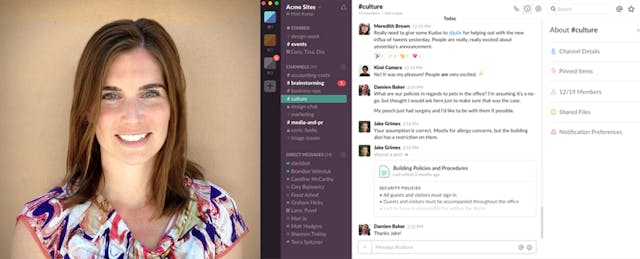What’s a typical day like for the director of learning at Slack, the fast-growing messaging app that aims to eliminate the need for e-mail? These days, it involves spending time thinking about Choose Your Own Adventure books.
That title belongs to Kristen Swanson, whose job is to develop trainings for its employees and to help explain the messaging tool to customers around the globe. For one of her latest efforts, called Slack Certification, her team developed a series of interactive scenarios partly inspired by those children’s’ books. Users select a character, read over the fictional person’s role and job duties, and then jump into the Slack app, where they interact with a chatbot (in character) to perform a task. It’s an unusual approach to explaining a product to the uninitiated.
“We want to give you an opportunity to make bad choices and see what happens, or make good choices and see what happens,” she says.
Before she landed at Slack, Swanson was already a well-known figure in edtech. She began her career as a third-grade teacher, later served as director of technology for a school district, then directed a research department at BrightBytes, which helps K-12 administrators and school leaders align school spending with learning outcomes. But she’s probably best known as founder of the Edcamp Foundation, which helps teachers run free, grassroots professional-development workshops. (She still chairs the board for the foundation.)
“There is something I learned about the power of play when I was an educator and when I was a school leader that has never left me,” says Swanson. “I think that there’s this sense sometimes when we get into the world of work that this no longer applies because this is a serious place where we do serious things.”
Swanson says she was drawn to Slack because of the role the company is playing in changing how people communicate with technology. “Communication has become instantaneous, informal and it’s also become multi-channel,” she says. In the past, people might hunt around for the right co-worker to ask a specific question. Today, finding the same answer may simply involve going to the right electronic channel where people on a team are sharing their work as they go.
One challenge of being at a fast-growing company, she says, is making sure information about how things work is maintained and shared as new employees quickly come onboard. While that involves formal trainings, she says she also pays attention to what she calls the “hidden curriculum” at her organization. That is communicated through a series of “microinteractions” people have every day, she says. “When you walk into a room in morning do people just get on their laptops?”
“Companies are seeing the impact that a strong culture can have,” she adds. “And companies are excited about thinking differently about the role of learning in an organization.”
'Pull Learning'
Swanson laid out some of her vision for professional learning at Slack in a 2016 blog post. “Instead of ‘pushing’ lots of mandatory content, we allow people to ‘pull what they need’ from an integration between Slack and Bridge, our learning management system,” she wrote. “Each learning experience is brief, targeted, and modular. Given that a ‘search first culture’ is one of the core assumptions underlying Slack (the product) — that is, proactively look to see if the answers you need exist before asking a question — it makes sense for our learning program to reflect that as well.”
Sean Gallagher, founder and executive director of Northeastern University’s Center for the Future of Higher Education and Talent Strategy, says that corporate learning is no longer the sleepy area it once was. And these days it could even have lessons for educators at schools and colleges.
“Corporate learning is designed to be hyper-targeted and sort of short and efficient,” he says. “Higher education is trending to faster and more targeted offerings as well.”
Katrina Stevens, a former U.S. Department of Education official (and former EdSurge employee) who is now an education consultant, has watched Swanson’s career and worked with her informally over the years. One of Swanson’s strengths, she says, is she understands education from many perspectives—as a teacher, administrator and researcher—and knows how to put big new ideas into practice.
One big idea she’s been particularly interested in is an approach called “understanding by design,” which focuses on starting backward from what you wants students to learn and planning the teaching to get there, championed by the late Grant Wiggins. Swanson worked for Wiggins as a design curriculum expert for a year and a half, and she has applied the approach in her later work.
“Beginning with the end in mind always leads to a stronger design,” she says. “Working with Grant was a highlight of my career and influences every design choice I make in my current role.”
As she continues her work at Slack, she says she never loses sight of lessons she learned as a teacher. What’s a classroom memory that sticks with her?
“For me there was a moment in my third-grade classroom where students were using Microsoft PowerPoint and we were having the kids create interactive games,” she recalls. “There was a student in this class who was working so hard on this project, and later she saw one of the other kids playing the game they created. What I saw on her face was, ‘Wow I have created something that has made an experience happen for someone else.’ It became this kid’s superpower.”
“That made me realize this idea of intentional design and immersing people in experiences could unlock this whole new future,” she says.


